la_asie
Active Member
- Joined
- Nov 28, 2018
- Messages
- 29
- Reaction score
- 77
Hello all,
There are some questions that I would like to know regarding this topic. I have searched the internet and found little to nothing relating to the topic of the history of clothing prices. My point is, high-quality suits are extremely expensive in the 21st century. High-end RTW suits such as Kiton, Brioni, Attolini, or Oxxford have a hefty price tag above $3,000 (retail). Bespoke suits in England cost pretty much the same and maybe more.
My question is if we go back in time to the 1900s, how much did a suit cost back then? Let's say if we go back to the 1900s in London, in a scenario where a working-class man needs to don a suit every day. How much did he have to pay for a suit? I believe that ready-to-wear stuff was still unavailable, so the only option for him was to go bespoke (either British or Chinese tailor I would guess). If the only option for him was to go bespoke, then the price should probably be high?
If anyone has insight, please enlighten me. I desperately need to know.
There are some questions that I would like to know regarding this topic. I have searched the internet and found little to nothing relating to the topic of the history of clothing prices. My point is, high-quality suits are extremely expensive in the 21st century. High-end RTW suits such as Kiton, Brioni, Attolini, or Oxxford have a hefty price tag above $3,000 (retail). Bespoke suits in England cost pretty much the same and maybe more.
My question is if we go back in time to the 1900s, how much did a suit cost back then? Let's say if we go back to the 1900s in London, in a scenario where a working-class man needs to don a suit every day. How much did he have to pay for a suit? I believe that ready-to-wear stuff was still unavailable, so the only option for him was to go bespoke (either British or Chinese tailor I would guess). If the only option for him was to go bespoke, then the price should probably be high?
If anyone has insight, please enlighten me. I desperately need to know.















